Almost exactly 11 months ago, I found myself analyzing a rather interesting company in the food space. Generally speaking, I don’t like to play much in this market because it is highly competitive and margins can be slim. But every so often, you come across a prospect that does look intriguing enough to at least consider. The company in question was Vital Farms (NASDAQ:VITL). And what drew me to it is how the company is almost single mindedly focused on a single product. And that’s eggs. In 2022, the firm did derive about 6.3% of its revenue from butter and butter related products. But all the rest of its sales came from shell eggs, hard boiled eggs, and liquid whole eggs.
While this may not seem like a strong growth area, the company has achieved rapid expansion in large part because there is a shift toward premium eggs that are sourced responsibly. And management has been effective in branding their offering in that way. To be clear, it’s not just branding. The company lives and breathes this philosophy. But without effectively promoting itself, it would be just another egg producer. In that article, I found the company interesting and I believed that it had potential. But because of how shares were priced at the time, I could not rate it anything better than a ‘hold’. Since then, a lot has changed. For starters, shares have dropped 18.2% at a time when the S&P 500 has risen by 5.8%. In addition to that, however, the company has achieved significant growth and it has an ambitious target for where revenue should be in the next few years. All combined, this has made me reevaluate the company and I have decided to rate it a solid ‘buy’ at this time. And if shares get much cheaper, I could upgrade it further to a ‘strong buy’.
Egg…cellent
Author – SEC EDGAR Data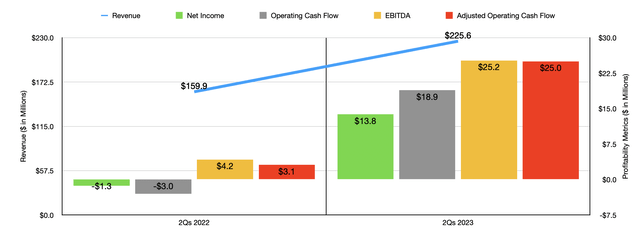
Recent financial performance achieved by Vital Farms has been truly impressive. Take revenue during the first half of the 2023 fiscal year. During that time, revenue totaled $225.6 million. That’s 41.1% higher than the $159.9 million the company generated the same time one year earlier. Higher volume contributed $25.2 million to the company’s growth during that time, with both new and existing customers proving to be beneficial for the company. It is worth noting, however, that most of the growth, about $40.5 million, can be attributed to price increases.
Federal Reserve
If this seems outrageous, keep in mind that, as shown in the chart above, the US did experience a rather significant surge in the price of eggs, with those prices peaking earlier this year. Weak production levels were driven by not only supply chain issues, but also, more importantly, the avian flu. In January of 2019, for instance, there were an estimated 341.8 million egg laying hens across the nation. That number declined over the next three years and, by January of 2022, the size of the flock had dropped to 326 million. It is interesting to note that a shift in consumer focus toward promoting cage free hens over caged ones did result in an increase in the number of cage free layers during this window of time.
Incredible Egg
While revenue for the company increased nicely, profits followed suit. The firm went from generating a net loss of $1.3 million in the first half of 2022 to generating a net profit of $13.8 million the same time of 2023. Other profitability metrics increased as well. Operating cash flow, for instance, went from negative $3 million to $18.9 million. Adjusted operating cash flow, which adjusts for changes in working capital, jumped from $3.1 million to $25 million. And finally, EBITDA for the company expanded from $4.2 million to $25.2 million.
For the current fiscal year, management is quite optimistic. This may seem peculiar to some given that egg prices have fallen significantly since peaking. Driven by higher volume that management chalked up to continued investments in its physical footprint, the firm came out with guidance when it reported second quarter results indicating that revenue this year should be in excess of $465 million. That’s significantly above the $362.1 million generated in 2022. Meanwhile, EBITDA for the company should be greater than $35 million. That’s more than double the $16.2 million generated one year earlier. A rough estimate from that would indicate adjusted operating cash flow for the year of roughly $34.8 million.
Author – SEC EDGAR Data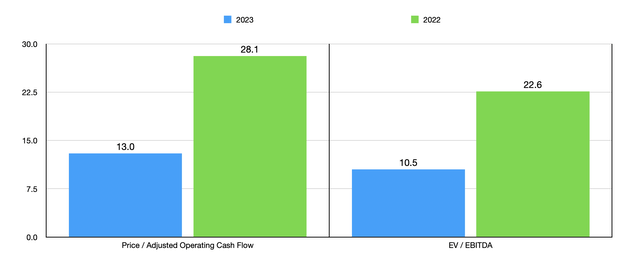
Given these figures, I was able to value the company as shown in the chart above. On a forward basis, the firm is trading at a price to adjusted operating cash flow multiple of 13. This is down nicely from the 28.1 reading that we get using data from 2022. Over the same window of time, the EV to EBITDA multiple looks to be dropping from 22.6 to 10.5. This takes the company from very expensive to very affordable very quickly.
Vital Farms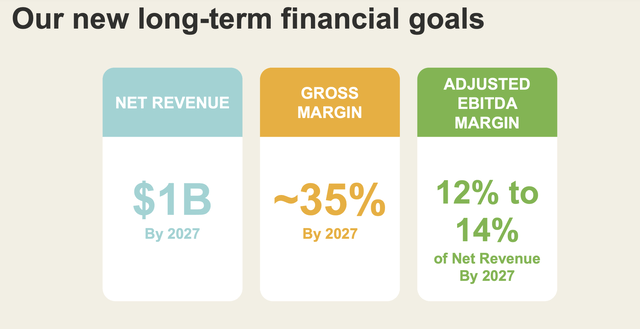
I can understand why some investors might be hesitant. This is especially true after seeing egg prices drop like they have. But management’s not banking on egg prices remaining elevated. Rather, they are putting all of their eggs in the growth basket. You see, by the end of 2027, the company expects to be generating annualized revenue in excess of $1 billion. That’s approximately triple what was generated last year. A lot of this growth will come from the company’s existing Egg Central Station. At full capacity, it’s capable of producing 6 million eggs per day which should, based on management’s estimates, result in over $700 million of net revenue each year. Other investments will make up the rest of that gap. And because the company has virtually no debt and it enjoys cash and cash equivalents in excess of debt that totals $85.7 million, it has the kind of balance sheet needed for expansion.
Vital Farms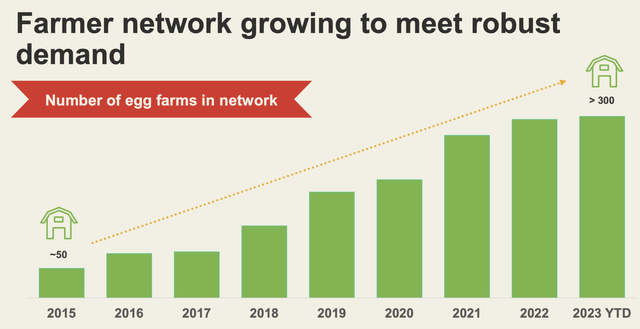
Of course, it would take more than increasing its physical footprint in order to achieve attractive growth. Part of the company’s strategy is to work with a network of farmers so as to source directly from them. Back in 2015, the company had only 50 farms in its network. So far this year, that number has grown to more than 300. There also appears to be significant potential within this market.
Vital Farms Vital Farms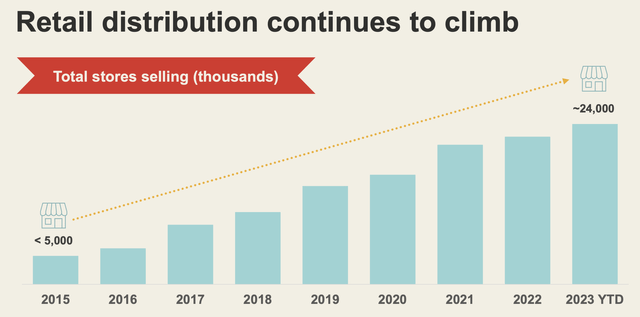
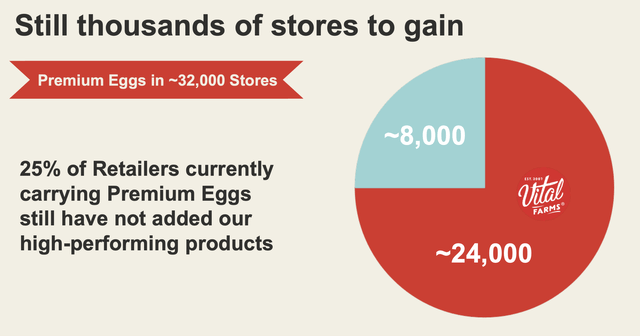
As of this year, the company sells its premium eggs in approximately 24,000 different stores. But the company sees an opportunity to expand this in the coming years to 32,000. This should help the company continue to get its eggs in more and more households. Back in 2015, the company estimated that its eggs only made it to approximately 0.8 million households. In 2022, this number stood at an impressive 10.5 million. However, the company believes that of the 131 million households in the US, 72 million are already buying premium eggs.
Vital Farms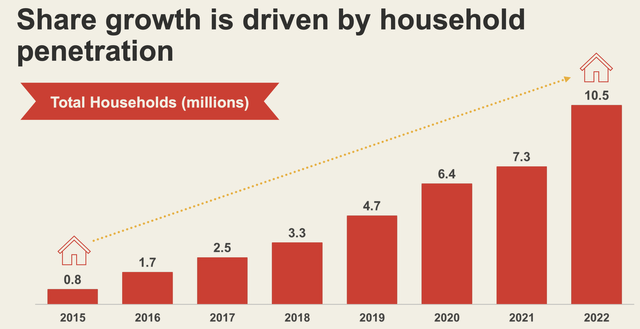
It’s also important to note that while there has been some weakness in terms of both the overall sales of eggs and the per capita consumption of eggs over the past few years, the latter metric indicates that consumption is still significantly above historical averages. And with the population of this country continuing to grow, with a target of 450 million people by 2100, it is almost certain that this trend will continue for the foreseeable future. Even if the company can only get to its $1 billion market size, the upside for investors from this point can be significant.
United Egg Producers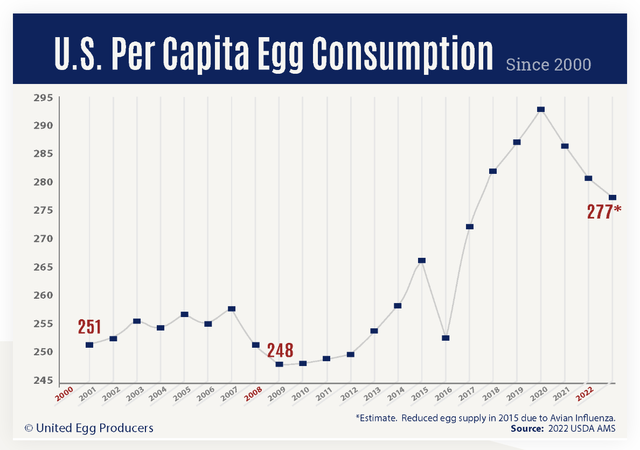
The company has forecasted that its EBITDA margin at that point will be between 12% and 14%. At the midpoint, that would translate to EBITDA of $130 million. Compared to how shares are trading today, that would result in an EV to EBITDA multiple of 2.8. If we assume that the fair value EV to EBITDA multiple for a company at that point would be 8, then by 2028 the firm would be worth over $1 billion, translating to annualized upside for shareholders of almost 30%.
Vital Farms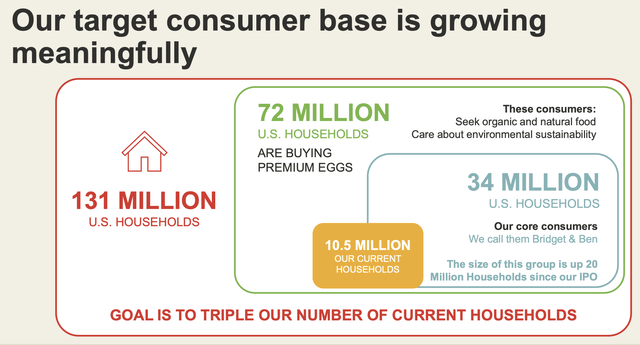
Diligent investors would be wise to keep in mind that conditions can change period and sometimes, those changes can be rapid. Because of this, it would be wise to pay attention to when management reports financial results for the third quarter of the 2023 fiscal year. This is expected to be November 2nd. At present, analysts are forecasting revenue of $110.2 million. This represents a decent increase over the $92 million generated one year earlier. While this does seem to indicate a possible deceleration of growth, much of that would likely be driven by the decline in egg prices that I have mentioned. But profits are still expected to rise nicely to $0.05 per share. That’s more than double the $0.02 per share generated in the third quarter of 2022. It would also represent an increase in earnings from only $0.7 million to $2.2 million. There are other profitability metrics that investors should pay attention to. Operating cash flow is one. In the third quarter of last year, the company reported negative $0.4 million for that. On an adjusted basis, it was considerably better at $6.2 million, while EBITDA came in at $5.2 million.
Author – SEC EDGAR Data
Takeaway
Based on the data provided, I must say that I have had a big change of heart when it comes to Vital Farms. Growth has been very impressive as of late and, while shares of the company were expensive, they have gotten a lot cheaper. I understand that growth plans are never guaranteed and there is always some risk banking on those. But when you consider how shares are already priced today, I do believe that the upside potential is great enough to warrant a ‘buy’ rating.
Read the full article here



